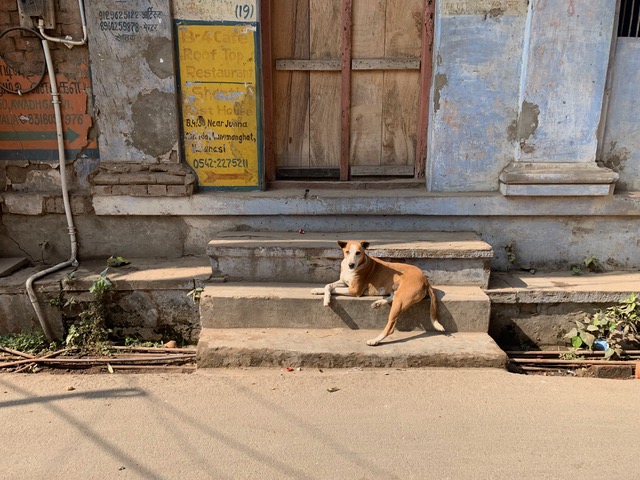In summer 2023, I adopted Moti, an Indie dog born in the garden of the house I rent during fieldwork in Banaras/Varanasi, India. Since bringing her back to Europe—and during subsequent returns to the city, where I continue to interact with dogs in the streets—I have often wondered whether she would have been happier as a free-living dog.
As often happens with rescue stories globally, her adoption was celebrated. Local newspapers in India carried stories about a street dog moving to the sweet life in Europe. More broadly, in the West, canine NGOs and self-styled ‘rescuers’ frame such adoptions as heroic gestures, the kind of salvation for which a dog should be grateful forever. Sure, Moti’s group was not welcome where they lived; their lives were at risk, so taking her elsewhere made sense. But I never felt like a hero, and the reality was more complicated. Working with gentle trainers and learning from people who specialise in free-living dogs in India, Italy, and Thailand, I now understand the struggles Moti carried into her new life: the lack of distance from what she perceives as potential threats, the confusion of human timetables and basically the loss of the independence her genes had wired her for. Living with Moti means learning how to provide support that makes sense to her and be a secure connection.
As an anthropologist, I began asking myself: Is ‘rescuing’ dogs a new form of extractivism from the global South? The answer is not straightforward. As many experts who work and learn with these dogs emphasise, each case must be examined individually, considering local circumstances, the dog’s welfare and the broader ecological and social context. More importantly, there is much to learn from Indies (and free-living dogs in general) when they’re left where they are—and the world of canine behaviour has only just begun to realise how much India can teach about this.
Not surprisingly, then, I was shocked when in summer 2025 the Supreme Court of India, acting suo motu, responded to a Times of India story framing ‘stray dogs’ as a rising menace. On 11 August, the Court ordered Delhi-NCR authorities to capture all ‘strays’ and move them to designated shelters, even though such shelters do not exist. The order also prohibited releasing sterilised and vaccinated dogs back into public spaces, in contravention of India’s animal welfare legislation. The decision triggered massive mobilisation across cities, with campaigners advocating humane, science-based solutions and urging proper implementation of sterilisation and vaccination programmes under the Animal Birth Control Rules, 2023. Later, the ruling was modified, but the whole controversy revealed broader lessons for anyone interested in urban ecologies.
To call these animals ‘strays’ misses their truth. Free-living dogs in India are woven into urban life and have lived alongside humans for centuries, as scavengers and vital custodians of the city’s ecology. They can also be teachers whose very presence in the city challenges the divide between the pet—bred, dependent, domesticated—and the unruly other, cast as menace or threat. And while ‘dog lovers’ have been criticised for being elitist and blind to human struggles, free-living dogs often bond and fight for life against and/or along with precisely the most vulnerable: hawkers, garbage pickers, and beggars who inhabit the same streets.
In India, their ambiguous presence pushes us to rethink the urban relationship with a more-than-human—and not solely for-the-human—environment. And particularly when we almost exclusively see dogs as pets, what can we learn from a companionship not determined by breeding or ownership? Who is afraid of free-living dogs?
Author Bio
Vera Lazzaretti is a Senior Researcher at the Centre for Research in Anthropology (CRIA) in Lisbon, currently working on the politics of heritage and security in urban South Asia and southern Europe. She studied Philosophy and Cultural Anthropology in Italy and holds a PhD in Indian and Tibetan Studies from the University of Turin (2013). Before joining the CRIA, she worked at the University of Milan, the University of Oslo and the South Asia Institute at Heidelberg University. Vera’s main field site is in urban north India, and her research interests include the anthropology of space and place; religion and politics; heritage; securitisation and policing; inter-religious violence; religious offence; pilgrimage; Hindu nationalism; and ethnography.
Banner Image Credits: The author



